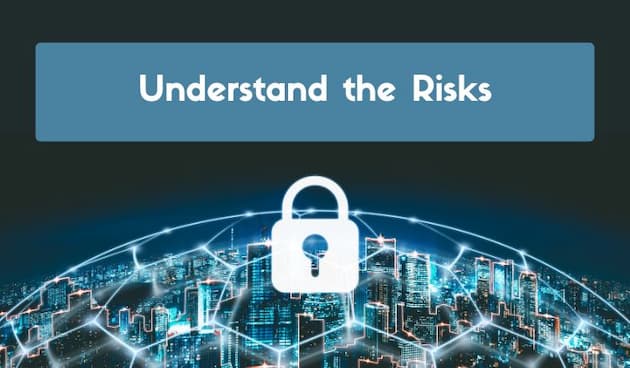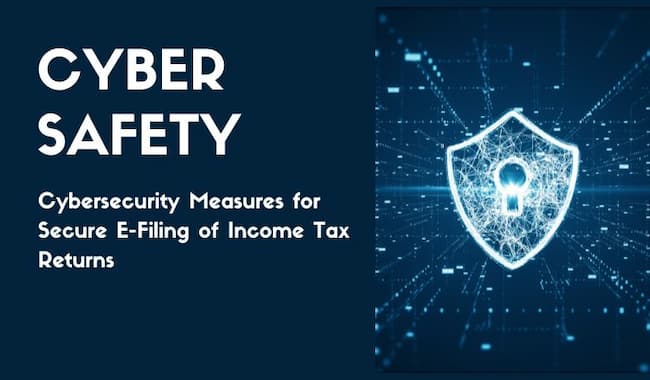In the present time, e-recording annual government forms have become progressively well known because of their accommodation and efficiency. Now taxpayers can save their time and effort by submitting their financial information digitally.
In any case, with the increase in the chances of digital dangers, it is important to execute network safety measures to guarantee the security of sensitive information.
To assist taxpayers in securely completing their e-filing of income tax returns, we will examine several important cybersecurity tips in this article.
Understand the Risks

You too know, how convenient and smooth the online filing of income tax process is. But this also comes with its fair share of risks. And keeping the threat in mind, it’s important to understand the potential threats that may arise in cyberspace. However, if you are aware of these risks, you can take proactive steps to protect yourself and your sensitive financial information.
Feeling of Urgency
During tax season, the rush and activity around tax filings become a good chance for cyber criminals to show their criminal skills. A usual trick they use is phishing attacks. In this, fraudsters pretend to be real groups or people and try to fool you. They ask for your personal details or want you to click on harmful links they send.
In most cases, they send you an email that appears to be from the tax authority, urging you to provide your credentials urgently. Now, how to be safe from them? The answer is you have to always stay alert and double-check the sender’s email address and the authenticity of the email before you take any action.
Malware and Ransomware
This kind of attack can harm your computer and keep your data locked unless you pay money to them. Scammers generally hide harmful software or file download links as real tax help software in emails.
To avoid this, you should ensure that your system has good antivirus software that is active. You also need to be careful when downloading files or clicking on links that don’t look natural.
Identity theft
Identity theft becomes a big worry with tax filings. Cheaters try to snatch your personal details, like your Social Security number, to file fake tax returns using your name.
This can take away your money and you have to spend a long time to fix the problem. That’s why you shouldn’t share your personal data everywhere and always try to give it only to safe and approved platforms.
Fake Websites
These sites mimic real tax service sites, mimic their functionality, and trick users in such a way that they start entering their personal information thinking that it is real.
Therefore, before using any tax software or site, research thoroughly whether it is reliable or not. Look for reviews, check for security certifications, and verify the legitimacy of the platform with official tax authorities.
Essential Cybersecurity Measures for Secure E-Filing of Income Tax Returns

Use Strong and Distinctive Passwords
By creating a strong and unique password, you can guard yourself with top privacy and security tech. A safe password has big and small letters, numbers, and special signs.
You should not use normal passwords that are easy to guess. For example, you should not use your names, birth dates, or phone numbers in a row. Therefore, you should use different passwords for different online accounts. This way, if any of your passwords are leaked, not all of your accounts will be at risk.
Turn on Two-Factor Authentication (2FA)
Adding two-factor authentication to your e-filing process gives an additional degree of protection. With this 2-FA feature enabled, you have to again pass a second verification method.
This is a one-time code given to your phone or email. So you should enable 2FA on your e-filing platform to reduce the chances of unauthorized access even if your password gets revealed.
Update and Protect Your Devices
If you keep updating your gadgets regularly, this step acts as another protective layer against possible attacks or vulnerabilities. These fixes come with operating system upgrades and security patches for known security issues.
You can guarantee that you have the most latest security against possible dangers by keeping your gadgets up to date.
Furthermore, it is also important to use trustworthy antivirus and antimalware software or apps to identify and delete any harmful software that may compromise your data.
Phishing Attacks Should Be Avoided
Phishing attacks are still a frequent method used by hackers to gain sensitive information. These efforts generally include fraudulent emails, text messages, or phone calls designed to fool people into disclosing personal or financial information.
Always proceed with care when replying to such requests to avoid phishing attempts. Before submitting any information, confirm the validity of the request. Avoid clicking on dodgy links and downloading files from unfamiliar sources.
Use Secure Wi-Fi Networks
It is also important nowadays to always use safe and reputable Wi-Fi networks while completing your income tax returns online. Hackers can easily exploit public or insecure Wi-Fi networks, such as those found at coffee shops, airports, or railway stations.
Instead of using public networks, use secure and encrypted networks that need a password, such as WPA2. Using a secure network guarantees that your data is securely sent.
You can use a virtual private network (VPN) to create a secure connection between your device and the e-filing of income tax return platform if required.
Store and Dispose of Sensitive Information Securely
Keeping cyber safe needs correct handling and throwing away sensitive tax papers. For digital records, keep them locked with codes and make sure they stay in safe spots.
It’s not just about keeping good passwords. It’s also about where and how you keep your important tax papers and files. Digital files should be locked with strong codes which are hard to guess. Also, keep backup copies in places you trust. This can be on a hard drive that you keep in a safe or even printed out on paper in a locked file cabinet.
Keep an Eye on Your Financial Statements regularly
Always keep a close eye on your financial records and this step is crucial to spot any unauthorized transfers immediately. Regularly check your bank statements, credit card bills, and other financial documents for any unusual activity. If you notice anything odd or out of place, alert your bank at once. If you can act fast, it can prevent further financial damage.
Conclusion
As e-filing income tax returns are now common, it’s important to put cybersecurity as your 1st priority to keep sensitive financial information safe. By following the cybersecurity tips given above, you can lower your risk of cyber-attacks and ensure your tax returns are filed safely.
As I said above, always use strong and unique passwords, turn on two-factor authentication, update your devices regularly, and stay alert to phishing tries. Taking these steps will help you go through the e-filing of income tax returns smoothly while protecting your personal and financial details.
What are the tips for Cybersecurity?
From the article, we can summarise that if you follow the below-mentioned steps, then most probably you will be free from cyber-attacks
1. Use Strong and Distinctive Passwords
2. Turn on Two-Factor Authentication (2FA)
3. Update and Protect Your Devices
4. Phishing Attacks Should Be Avoided
5. Use Secure Wi-Fi Networks
6. Store and Dispose of Sensitive Information Securely
7. Keep an Eye on Your Financial Statements on a Regular Basis
What are the 5 C’s of cybersecurity?
The 5 C’s of cybersecurity are Change, Compliance, Coverage, Cost, and Continuity. These factors help organizations enhance their security measures:
Change: Adapt and update security measures to address evolving threats.
Compliance: Adhere to laws, regulations, and industry standards.
Coverage: Implement comprehensive security measures across all areas.
Cost: Balance security investments with available resources.
Continuity: Plan for incident response and recovery to ensure business continuity.